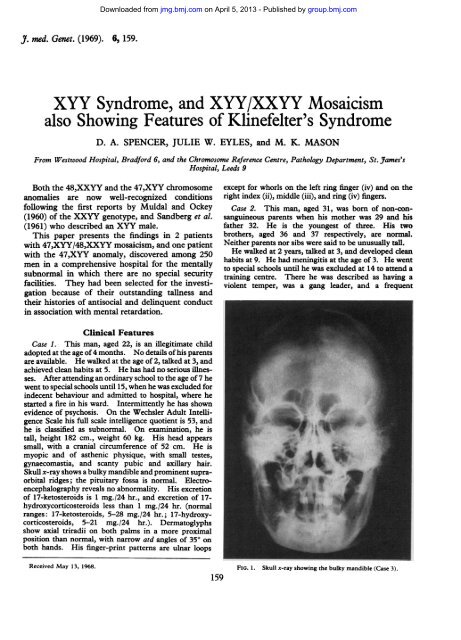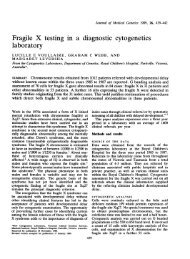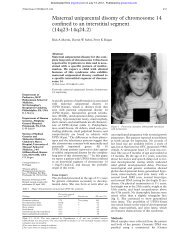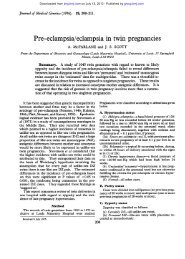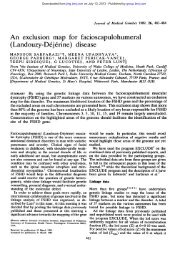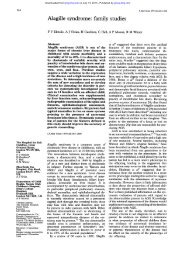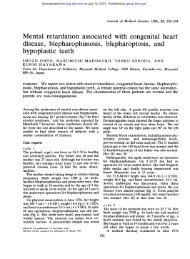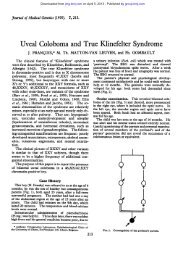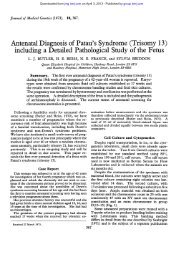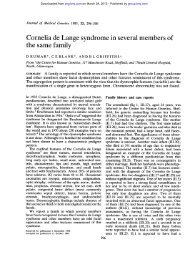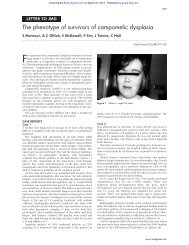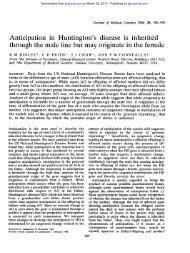XYY Syndrome, and XYY/XXYY Mosaicism also Showing Features ...
XYY Syndrome, and XYY/XXYY Mosaicism also Showing Features ...
XYY Syndrome, and XYY/XXYY Mosaicism also Showing Features ...
You also want an ePaper? Increase the reach of your titles
YUMPU automatically turns print PDFs into web optimized ePapers that Google loves.
J. med. Genet. (1969). 6, 159.<br />
Downloaded from<br />
jmg.bmj.com on April 5, 2013 - Published by group.bmj.com<br />
<strong>XYY</strong> <strong>Syndrome</strong>, <strong>and</strong> <strong>XYY</strong>/X<strong>XYY</strong> <strong>Mosaicism</strong><br />
<strong>also</strong> <strong>Showing</strong> <strong>Features</strong> of Klinefelter's <strong>Syndrome</strong><br />
D. A. SPENCER, JULIE W. EYLES, <strong>and</strong> M. K. MASON<br />
From Westwood Hospital, Bradford 6, <strong>and</strong> the Chromosome Reference Centre, Pathology Department, St. James's<br />
Hospital, Leeds 9<br />
Both the 48,X<strong>XYY</strong> <strong>and</strong> the 47,<strong>XYY</strong> chromosome<br />
anomalies are now well-recognized conditions<br />
following the first reports by Muldal <strong>and</strong> Ockey<br />
(1960) of the X<strong>XYY</strong> genotype, <strong>and</strong> S<strong>and</strong>berg et al.<br />
(1961) who described an <strong>XYY</strong> male.<br />
This paper presents the findings in 2 patients<br />
with 47,<strong>XYY</strong>/48,X<strong>XYY</strong> mosaicism, <strong>and</strong> one patient<br />
with the 47,<strong>XYY</strong> anomaly, discovered among 250<br />
men in a comprehensive hospital for the mentally<br />
subnormal in which there are no special security<br />
facilities. They had been selected for the investigation<br />
because of their outst<strong>and</strong>ing tallness <strong>and</strong><br />
their histories of antisocial <strong>and</strong> delinquent conduct<br />
in association with mental retardation.<br />
Clinical <strong>Features</strong><br />
Case 1. This man, aged 22, is an illegitimate child<br />
adopted at the age of 4 months. No details of his parents<br />
are available. He walked at the age of 2, talked at 3, <strong>and</strong><br />
achieved clean habits at 5. He has had no serious illrnesses.<br />
After attending an ordinary school to the age of 7 he<br />
went to special schools until 15, when he was excluded for<br />
indecent behaviour <strong>and</strong> admitted to hospital, where he<br />
started a fire in his ward. Intermittently he has shown<br />
evidence of psychosis. On the Wechsler Adult Intelligence<br />
Scale his full scale intelligence quotient is 53, <strong>and</strong><br />
he is classified as subnormal. On examination, he is<br />
tall, height 182 cm., weight 60 kg. His head appears<br />
small, with a cranial circumference of 52 cm. He is<br />
myopic <strong>and</strong> of asthenic physique, with small testes,<br />
gynaecomastia, <strong>and</strong> scanty pubic <strong>and</strong> axillary hair.<br />
Skull x-ray shows a bulky m<strong>and</strong>ible <strong>and</strong> prominent supraorbital<br />
ridges; the pituitary fossa is normal. Electroencephalography<br />
reveals no abnormality. His excretion<br />
of 17-ketosteroids is 1 mg./24 hr., <strong>and</strong> excretion of 17hydroxycorticosteroids<br />
less than 1 mg./24 hr. (normal<br />
ranges: 17-ketosteroids, 5-28 mg./24 hr.; 17-hydroxycorticosteroids,<br />
5-21 mg./24 hr.). Dermatoglyphs<br />
show axial triradii on both palms in a more proximal<br />
position than normal, with narrow atd angles of 350 on<br />
both h<strong>and</strong>s. His finger-print patterns are ulnar loops<br />
except for whorls on the left ring finger (iv) <strong>and</strong> on the<br />
right index (ii), middle (iii), <strong>and</strong> ring (iv) fingers.<br />
Case 2. This man, aged 31, was born of non-consanguineous<br />
parents when his mother was 29 <strong>and</strong> his<br />
father 32. He is the youngest of three. His two<br />
brothers, aged 36 <strong>and</strong> 37 respectively, are normal.<br />
Neither parents nor sibs were said to be unusually tall.<br />
He walked at 2 years, talked at 3, <strong>and</strong> developed clean<br />
habits at 9. He had meningitis at the age of 3. He went<br />
to special schools until he was excluded at 14 to attend a<br />
training centre. There he was described as having a<br />
violent temper, was a gang leader, <strong>and</strong> a frequent<br />
Received May 13, 1968. FIG. 1. Skull x-ray showing the bulky m<strong>and</strong>ible (Case 3).<br />
159
160<br />
...<br />
$ -- -'-- ., . ;.. .<br />
Spencer, Eyles, <strong>and</strong> Mason<br />
: s-' ,' f° . 1!--!h"<br />
"" o- '~~~~~~~~~~~~~~~~~~~~~~~~~~~~~~~~~~~~~--- ---<br />
Downloaded from<br />
jmg.bmj.com on April 5, 2013 - Published by group.bmj.com<br />
-<br />
. ., .- .. ,<br />
...... v4h ^i<br />
absconder. He has a tendency to w<strong>and</strong>er, has been guilty<br />
of breaking <strong>and</strong> entering <strong>and</strong> larceny, <strong>and</strong> he has been<br />
known to inflict injuries on himself. He has a full-scale<br />
intelligence quotient of 55 (Wechsler Adult Intelligence<br />
Scale), <strong>and</strong> is classified as subnormal.<br />
He is tall, height 189 cm., <strong>and</strong> his weight is 77 kg. His<br />
cranial circumference, 58 cm., is normal. His testes<br />
are small; he has scanty pubic <strong>and</strong> axillary hair, but no<br />
gynaecomastia. Both eyes show optic atrophy. His<br />
skull x-ray shows a bulky m<strong>and</strong>ible, with prominent<br />
supra-orbital ridges <strong>and</strong> a normal pituitary fossa. His<br />
electroencephalogram reveals no specific abnormalities.<br />
Excretion of 17-ketosteroids is 8 mg.f 24 hr., <strong>and</strong> of 17hydroxy-corticosteroids<br />
5-5 mg./24 hr. His dermatoglyphs<br />
show axial triradii on both palms in a more distal<br />
position than normal with atdangles of 520on both h<strong>and</strong>s.<br />
A hypothenar pattern, a carpal loop, is present on the<br />
right palm only. The finger-prints are mainly ulnar loops<br />
with whorls on both thumbs <strong>and</strong> the right ring finger (iv),<br />
<strong>and</strong> a radial loop on the right index finger (ii).<br />
Case 3. This man, aged 22, was born of non-consanguineous<br />
parents when his mother was 26 <strong>and</strong> his<br />
FIG. 2. Karyotype of Case 1, showing 47,<strong>XYY</strong> chromosomes.<br />
father 31. The parents were not said to be unusually tall.<br />
He is the eldest of three. His two sisters, aged 12 <strong>and</strong><br />
20, are normal. He walked at 2 years, talked at 3, <strong>and</strong><br />
had clean habits at 4. He has had no serious illnesses.<br />
He attended special schools <strong>and</strong> was admitted to a hospital<br />
for the mentally subnormal at the age of 15 after being<br />
found guilty of indecent assault. His full-scale intelligence<br />
quotient (Wechsler Adult Intelligence Scale) is<br />
49 <strong>and</strong> he is classified as severely subnormal.<br />
He is tall, height 188 cm., <strong>and</strong> he weighs 77 kg. His<br />
cranial circumference is 56 cm. His testes <strong>and</strong> hair<br />
distribution are normal <strong>and</strong> he has no physical abnormalities<br />
except for flexion deformities at the proximal<br />
interphalangeal joints of the middle, ring, <strong>and</strong> little<br />
fingers on both h<strong>and</strong>s. He is myopic. Skull x-ray<br />
shows a flattened occiput, a bulky m<strong>and</strong>ible (Fig. 1),<br />
<strong>and</strong> prominent frontal protruberances; the pituitary fossa<br />
is normal. Electroencephalography reveals no abnormalities.<br />
17-ketosteroid excretion is 6-5 mg./24 hr.,<br />
<strong>and</strong> 17-hydroxycorticosteroid excretion is 6 mg./24 hr.<br />
Dermatoglyphs show proximal axial triradii on both<br />
palms with narrow atd angles of 38° on both h<strong>and</strong>s. His<br />
finger-print patterns are ulnar loops except for an arch on<br />
..<br />
1'
Downloaded from<br />
jmg.bmj.com on April 5, 2013 - Published by group.bmj.com<br />
the right index finger (ii), <strong>and</strong> a radial loop on the left<br />
ring finger (iv).<br />
Cytogenetic Findings<br />
Samples taken from the three patients included buccal<br />
smears, a plain blood film <strong>and</strong> venous blood for chromosome<br />
analysis.<br />
Blood cultures prepared from separated leucocytes<br />
were set up according to a modified technique of Moorhead<br />
et al. (1960) <strong>and</strong> incubated for 72 hours. Microcultures<br />
were <strong>also</strong> set up using 0-25 ml. of whole blood.<br />
The results of these studies are summarized in the Table.<br />
TABLE<br />
CHROMOSOME COUNTS<br />
Case<br />
No.<br />
Chromosome<br />
Count<br />
Total No.<br />
of Cells<br />
Examined<br />
46 47 48 49<br />
1 1 22 511 1 75<br />
2 6 28 23 - 57<br />
3 1 33 - - 34<br />
<strong>XYY</strong> <strong>Syndrome</strong>, <strong>and</strong> <strong>XYY</strong>/X<strong>XYY</strong> <strong>Mosaicism</strong><br />
as<br />
---l-', ON M<br />
rft<br />
.SUVA L..:A 5'<br />
,' .; i n. 'i r- i-S<br />
FIG. 3. Karyotype of Case 1, showing 48,X<strong>XYY</strong> chromosomes.<br />
*Y Y X.X<br />
161<br />
Case 1. 42% of cells in the buccal smear were chromatin<br />
positive. Seven drumsticks were counted among<br />
300 neutrophils in the blood film.<br />
Blood culture revealed 2 cell-lines, one with 47 <strong>and</strong><br />
one with 48 chromosomes. Detailed karyotypic analysis<br />
of 10 metaphases of the 47 cell-line showed two Y chromosomes<br />
together with 15 chromosomes in the C group,<br />
the extra one presumed to be an X chromosome (47,<strong>XYY</strong>)<br />
(Fig. 2). Analysis of 10 cells of the 48 cell-line showed<br />
the presence of two Y <strong>and</strong> two X chromosomes (48,<br />
X<strong>XYY</strong>) (Fig. 3 <strong>and</strong> 4).<br />
One cell had a modal count of 49 <strong>and</strong> analysis revealed<br />
a probable sex chromosome complement of XX<strong>XYY</strong>.<br />
It is possible that this cell represents a third stem-line.<br />
Case 2. 12% of cells in the buccal smear were<br />
chromatin positive. Among 500 neutrophils in the<br />
blood film, 5 drumsticks were counted.<br />
Blood culture again showed two cell-lines of 47 <strong>and</strong> 48<br />
chromosomes. Karyotypic analysis of 10 cells of each<br />
of the cell-lines showed a chromosome complement of<br />
47,<strong>XYY</strong> <strong>and</strong> 48,X<strong>XYY</strong> respectively, as in Case 1 (Fig. 5<br />
<strong>and</strong> 6). Analysis of the six cells with 46 chromosomes
162<br />
*W n ~~~~~~~~~~~~~~. .. .....;<br />
Downloaded from<br />
jmg.bmj.com on April 5, 2013 - Published by group.bmj.com<br />
Spencer, Eyles, <strong>and</strong> Mason<br />
.1. .<br />
showed that the missing chromosome varied in each cell,<br />
<strong>and</strong> these cells were presumed to be artefacts.<br />
The proportion of cells with the karyotype of48,X<strong>XYY</strong><br />
(about 50%) may be reflected in the relatively low buccal<br />
<strong>and</strong> blood smear counts.<br />
Case 3. No cells in the buccal smear showed sex<br />
chromatin, <strong>and</strong> among 300 neutrophils in the blood<br />
film no drumsticks were observed. Of the metaphases<br />
examined from the blood cultures, 33 had a modal count<br />
of 47, <strong>and</strong> analysis of 10 of these revealed a chromosome<br />
complement of 47,<strong>XYY</strong> (Fig. 7).<br />
In all three cases the Y chromosomes were easily distinguished<br />
from the G group, being somewhat larger<br />
<strong>and</strong> having parallel long arms.<br />
Discussion<br />
The patients described in this paper were found<br />
when a special survey was conducted in the hospital<br />
on all the male patients who were at least 6 feet<br />
(183 cm.) tall, <strong>and</strong> showed criminal tendencies.<br />
There were 5 men who came into this category;<br />
they were studied by means of blood <strong>and</strong> buccal<br />
smears <strong>and</strong> chromosome analysis. No chromosome<br />
abnormality was found in 2, <strong>and</strong> the other 3 revealed<br />
the abnormalities already described.<br />
FIG. 4. Metaphase spread of the karyotype shown in Fig. 3.<br />
Clinical <strong>Features</strong>. The 3 patients in this investigation<br />
were all tall, mentally retarded, <strong>and</strong> had<br />
histories of antisocial <strong>and</strong> delinquent conduct such<br />
as have previously been associated with the YY<br />
syndrome (Jacobs et al., 1965; Casey et al., 1966a, b).<br />
The two patients with 47,<strong>XYY</strong>/48,X<strong>XYY</strong> mosaicism<br />
showed the physical features of Klinefelter's syndrome<br />
in addition. We have been unable to find<br />
an account of this mosaic in the literature, <strong>and</strong> the<br />
only comparable case we have been able to discover<br />
is one of 47,XXY/47,<strong>XYY</strong> mosaicism, reported by<br />
Gilgenkrantz, Hartemann, <strong>and</strong> Arnould (1964) in a<br />
patient with the physical stigmata of Klinefelter's<br />
syndrome but only 171 cm. tall. The Klinefelter<br />
phenotype appears to be associated with the presence<br />
of the additional X chromosome in these<br />
cases.<br />
Our three patients all had an acromegalic skull<br />
configuration, with bulky m<strong>and</strong>ibles <strong>and</strong> prominent<br />
supra-orbital ridges. This particular feature was<br />
recorded in a case of an X<strong>XYY</strong> man described by<br />
EJlis et al. (1961), <strong>and</strong> in a case of an XX<strong>XYY</strong> man<br />
reported by Bray <strong>and</strong> Josephine (1963). In Case 1<br />
the 17-ketosteroid <strong>and</strong> 17-hydroxycorticosteroid excretions<br />
were below normal, as may be found in
Downloaded from<br />
jmg.bmj.com on April 5, 2013 - Published by group.bmj.com<br />
Klinefelter's syndrome. In Cases 2 <strong>and</strong> 3 the<br />
values were just within the normal range. Dermatoglyphs<br />
in Cases 1 <strong>and</strong> 3 showed proximally<br />
situated axial triradii with small atd angles such as<br />
are found in the YY <strong>and</strong> Klinefelter's syndromes.<br />
Case 2 had more distally placed axial triradii with<br />
larger atd angles, <strong>and</strong> on the right h<strong>and</strong> a carpal loop<br />
in the hypothenar area, a characteristic found in<br />
cases with the 48,X<strong>XYY</strong> chromosome complement<br />
(Uchida, Miller, <strong>and</strong> Soltan, 1964). The fingerprint<br />
patterns were less typical.<br />
As the two patients with 47,<strong>XYY</strong>/48,X<strong>XYY</strong><br />
mosaicism showed certain features of both Klinefelter's<br />
<strong>and</strong> the YY syndrome, their classification<br />
poses a problem. Because they exhibit characteristics<br />
of Klinefelter's syndrome they could be called<br />
YY mosaic variants of this syndrome or, alternatively,<br />
X<strong>XYY</strong> Klinefelter mosaic variants of the YY<br />
syndrome.<br />
Cytogenetic Findings. There are several ways<br />
in which the cell-lines in the two mosaics could have<br />
<strong>XYY</strong> <strong>Syndrome</strong>, <strong>and</strong> <strong>XYY</strong>/X<strong>XYY</strong> <strong>Mosaicism</strong><br />
FIG. 5. Karyotype of Case 2, showing 47,<strong>XYY</strong> chromosomes.<br />
163<br />
originated. The production of a normal XY zygote,<br />
followed immediately by double non-disjunction of<br />
the sex chromosomes, would give the 48,X<strong>XYY</strong><br />
cell-line (Fig. 8); further non-disjunction of one pair<br />
of X's would then give the 47,<strong>XYY</strong> <strong>and</strong> 49,XX<strong>XYY</strong><br />
cell-lines. This mechanism seems the most probable<br />
because it involves mitotic non-disjunction<br />
only. It explains Case 1, assuming the 49 cell is not<br />
artefact, <strong>and</strong> it can <strong>also</strong> explain Case 2 though no<br />
cells with 49 chromosomes were found.<br />
There are other possible explanations postulating<br />
the formation of abnormal zygotes, either 47,<strong>XYY</strong><br />
or 48,X<strong>XYY</strong>, followed by further non-disjunction.<br />
As these mechanisms would involve both meiotic<br />
<strong>and</strong> mitotic non-disjunction <strong>and</strong> the production of<br />
unwanted cell-lines, they are considered less likely.<br />
Summary<br />
This paper reports two cases of47,<strong>XYY</strong>/48,X<strong>XYY</strong><br />
mosaicism <strong>and</strong> a case of the 47,<strong>XYY</strong> syndrome found<br />
in a hospital for the mentally subnormal in which
164<br />
!..J-<br />
~~~~~~~~~~~~~w o<br />
Spencer, Eyles, <strong>and</strong> Mason<br />
SMU'<br />
,- B--.<br />
'l .a_.-.<br />
*''-5::<br />
c . I<br />
_.B.kz<br />
..... .... ......*.S<br />
Downloaded from<br />
jmg.bmj.com on April 5, 2013 - Published by group.bmj.com<br />
- ______<br />
* L<br />
there are no special security facilities. 47,<strong>XYY</strong>/48,<br />
X<strong>XYY</strong> mosaicism has not been previously reported.<br />
All the cases showed mental subnormality, tallness,<br />
<strong>and</strong> antisocial <strong>and</strong> delinquent behaviour, together<br />
with some acromegalic features. The two patients<br />
with mosaicism <strong>also</strong> had many of the features of<br />
Klnefelter's syndrome. Hypotheses concerning<br />
the origin of the mosaicism are presented <strong>and</strong> the<br />
question of the classification of these mosaics is<br />
considered.<br />
We are grateful to Mr. D. N. Howard <strong>and</strong> the Medical<br />
Photographic Department, St. James's Hospital, for the<br />
photographs.<br />
REFRENcEs<br />
Bray, P., <strong>and</strong> Josephine, Sister Ann (1963). An XX<strong>XYY</strong> sexchromosome<br />
anomaly. Report of a mentally deficient male. J.<br />
Amer. med. Ass., 184,179.<br />
I 5<br />
U'<br />
a<br />
FIG. 6. Karyotype of Case 2, showing 48,X<strong>XYY</strong> chromosomes.<br />
.. _._. I<br />
Casey, M. D., Blank, C. E., Street, D. R. K., Segall, L. J.,<br />
McDougall, J. H., McGrath, P. J., <strong>and</strong> Skinner, J. L. (1966a).<br />
YY chromosomes <strong>and</strong> antisocial behaviour. Lancer, 2,859.<br />
-, Segall, L. J., Street, D. R. K., <strong>and</strong> Blank, C. E. (1966b). Sex<br />
chromosome abnormalities in two state hospitals for patients requiring<br />
special security. Nature (Lond.), 209,641.<br />
Ellis, J. R., Miller, 0. J., Penrose, L. S., <strong>and</strong> Scott, G. E. B. (1961).<br />
A male with X<strong>XYY</strong> chromosomes. Ann. hum. Genet., 25, 145.<br />
Gilgenkrantz, Mme., Hartemann, P., <strong>and</strong> Arnould, G. (1964).<br />
Mosaique XXY/<strong>XYY</strong> et syndrome de Klinefelter. Ann. med.<br />
(Nancy), 3, 966.<br />
Jacobs, P. A., Brunton, M., Melville, M. M., Brittain, R. P., <strong>and</strong><br />
McClemont, W. F. (1965). Aggressive behaviour, mental subnormality,<br />
<strong>and</strong> the <strong>XYY</strong> male. Nature (Lond.), 208,1351.<br />
Moorhead, P. S., Nowell, P. C., Mellman, W. J., Battips, D. M., <strong>and</strong><br />
Hungerford, D. A. (1960). Chromosome preparations of leukocytes<br />
cultured from human peripheral blood. Exp. Cell Res., 20,<br />
613.<br />
Muldal, S., <strong>and</strong> Ockey, C. H. (1960). The 'double male': a new<br />
chromosome constitution in Klinefelter's syndrome. Lancet, 2,492.<br />
S<strong>and</strong>berg, A. A., Koepf, G. F., Ishihara, T., <strong>and</strong> Hauschka, T. S.<br />
(1961). An <strong>XYY</strong> human male. ibid., 2,488.<br />
Uchida, I. A., Miller, J. R., <strong>and</strong> Soltan, H. C. (1964). Dermatoglyphics<br />
associated with the X<strong>XYY</strong> chromosome complement.<br />
Amer. J. hum. Genet., 16, 284.
Downloaded from<br />
jmg.bmj.com on April 5, 2013 - Published by group.bmj.com<br />
ovum<br />
<strong>XYY</strong> <strong>Syndrome</strong>, <strong>and</strong> <strong>XYY</strong>IX<strong>XYY</strong> Mosawcism16<br />
aj<br />
*6 h<br />
"A.<br />
_I~~~~~~~~~~~~~~~~~~~~~~~~~~~~~~~~~~~~~~~~~~~~~~~~~~~~~~~~~~~~~~~~~~~~~~~~~r ~~~~~~....<br />
FIG. 7. Karyotype of Case 3, showing 47,<strong>XYY</strong> chromosomes.<br />
'i MO..<br />
N.W.P...~ '<br />
non - disjunction<br />
after several<br />
divisions<br />
FIG. 8. Suggested mechanism for the production of the mosaicism.<br />
165
Downloaded from<br />
jmg.bmj.com on April 5, 2013 - Published by group.bmj.com<br />
Email alerting<br />
service<br />
Notes<br />
<strong>XYY</strong> syndrome, <strong>and</strong><br />
<strong>XYY</strong>-X<strong>XYY</strong> mosaicism <strong>also</strong><br />
showing features of<br />
Klinefelter's syndrome.<br />
D A Spencer, J W Eyles <strong>and</strong> M K Mason<br />
J Med Genet 1969 6: 159-165<br />
doi: 10.1136/jmg.6.2.159<br />
Updated information <strong>and</strong> services can be found<br />
at:<br />
http://jmg.bmj.com/content/6/2/159.citation<br />
These include:<br />
To request permissions go to:<br />
http://group.bmj.com/group/rights-licensing/permissions<br />
To order reprints go to:<br />
http://journals.bmj.com/cgi/reprintform<br />
To subscribe to BMJ go to:<br />
http://group.bmj.com/subscribe/<br />
Receive free email alerts when new articles cite<br />
this article. Sign up in the box at the top right<br />
corner of the online article.


